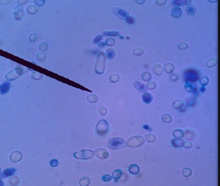Prototheca zopfii
| Prototheca zopfii | |
|---|---|

| |
| Methylene blue staining of P. zopfii genotype II | |
| Scientific classification | |
| (unranked): | Viridiplantae |
| Division: | Chlorophyta |
| Class: | Trebouxiophyceae |
| Order: | Chlorellales |
| Family: | Chlorellaceae |
| Genus: | Prototheca |
| Species: | P. zopfii
|
| Binomial name | |
| Prototheca zopfii W.Krüger
| |
Prototheca zopfii is aerobic, unicellular, yeast-like, achlorophyllic (without chlorophyll) microalga.[1]
Genome
The genome of this organism's mitochondrion and plastid were first sequenced in 2018.[2]
Reproduction
Prototheca zopfii reproduce asexually by endosporulation.[3]
Culture media
Sabouraud agar is used as a cultural medium.[4]
Distribution
Prototheca zopfii[5] is opportunistic, environmental pathogen and ubiquitous in nature. This alga is mainly associated with wet areas and places with high organic contents. It can be found in tanks, well water, teat-dip containers, and milking machines.[6]
Infection
The species can infect man and animal, causing mastitis.[7] P. zopfii can cause bovine clinical mastitis in high milk-yielding cows.[8] Genotypes I and III, traditionally, are thought not to be involved in the pathogenicity of mastitis and to be pollutants of milk, whereas genotype II is believed the main cause of mastitis.[7] However, in 2017, three cases of human protothecosis due to P. zopfii genotype I have been reported in China.[9]
Diagnosis
Polymerase chain reaction and restriction fragment length polymorphism analysis are useful tool for rapid confirmative diagnosis.[7]
Outbreaks
Bovine mastitis outbreaks by P. zopfii is a global problem. It is reported from Europe,[10][11][12] Asia,[13] North America,[14][15] and South America.[16][17]
Antimicrobial therapy
Prototheca zopfii is less susceptible or completely resistant to clotrimazole, fluconazole, econazole, flucytosine, cefoperazone, cephalexin, enrofloxacin, lincomycin, oxytetracycline, miconazole, colistin, a combination of amoxicillin with clavulanic acid, enrofloxacin, amoxicillin, tetracycline, penicillin, lincomycin, and novobiocin, whereas drugs such as nystatin, ketoconazole, and amphotericin B are effective against algae isolated from milk of mastitis-affected cows.[4]
References
- ↑ Ueno, R., Urano, N. and Suzuki, M. (2003). Microbiol. Lett., 223:275-280.
- ↑ Severgnini M, Lazzari B, Capra E, Chessa S, Luini M, Bordoni R, Castiglioni B, Ricchi M, Cremonesi P (2018) Genome sequencing of Prototheca zopfii genotypes 1 and 2 provides evidence of a severe reduction in organellar genomes. Sci Rep 8(1):14637. doi: 10.1038/s41598-018-32992-0.
- ↑ Bovine Mastitis, Neelesh Sharma et al., 2012, Satish Serial Publishing House. ISBN 978-93-81226-03-2. pp. 175-177.
- ↑ 4.0 4.1 Antimicrobial susceptibility of Prototheca zopfii isolated from bovine mastitis., Władysław Wawron, Mariola Bochniarz, Tomasz Piech, Jerzy Wysocki1, Marcin Kocik., Bull Vet Inst Pulawy 57, 485-488, 2013.DOI: 10.2478/bvip-2013-0084
- ↑ Roesler U, Moller A, Hensel A, et al. Diversity within the current algal species Prototheca zopfii: a proposal for two Prototheca zopfii genotypes and description of a novel species, Prototheca blaschkeae sp. nov. Int J Syst Evol Microbiol 2006;56:1419—25.
- ↑ Osumi, T., Kishimoto, Y., Kano, R., Maruyama, H., Onozaki, M., Makimura, K., Ito, T., Matsubara, K. and Hasegawa, A (2008). Vet. Microbiol., 131(3-4):419-423.
- ↑ 7.0 7.1 7.2 Molecular characterization of Prototheca strains isolated from bovine mastitis., A. Aouay , F. Coppée , S. Cloet , P. Cuvelier , A. Belayew , P.-E. Lagneau , C. Mullender ., Journal de Mycologie Médicale (2008) 18, 224—227.
- ↑ Janosi,S., Ratz., F.., Szigeti, G., Kulcsar, M., Kerenyi, J., Lomko, T., Katona, F. and Huszenicza, G. (2001). Vet. Quart., 23: 58-61.
- ↑ Molecular Characterization of Prototheca strains isolated in China revealed the first cases of protothecosis associated with Prototheca zopfii genotype 1., N. Hirose, Z. Hua, Y. Kato, Q. Zhang, R. Li, K. Nishimura, M. Masuda ., Medical Mycology (2017) doi: 10.1093/mmy/myx039.
- ↑ Lagneau, P.E.(1996).J. Mycol.Med.6:145-148.
- ↑ Aalbaek, B., Jensen, H.E. and Huda, A.(1998). Acta Pathol. Microbiol. Immunol.Scand., 106:483-488.
- ↑ Buzzini, P., Turchetti, B., Facelli,R., Baudino, R., Cavarero,F., Mattalia, L., Mosso, P. and Martini,A. (2004). Mycopathologia,158:427:430).
- ↑ Katoch,R.C.., Nagal,K.B., Sharma, M.(1997). Indian J. Anim. Sci.,67:292-93.
- ↑ Anderson, K.L. and Walker, R.L.(1988). J. Am. Vet. Med.Assoc.,193:553-556
- ↑ Higgins, R., and Larouche, Y.(1989). Med. Vet. Quebec, 19:140-141.
- ↑ Almeraya, A.P.(1994). Vet. Mexico, 25: 65-67
- ↑ Vargas, A.C.., Lazzari, A., Santurio,J.M.,Alves,S.H., Ferreira,G.,and Kreutz.,L.C.(1998). Mycopathologia, 142:135-137